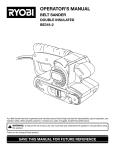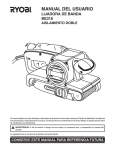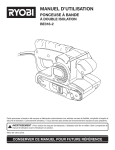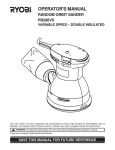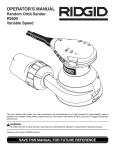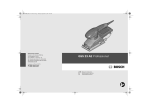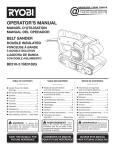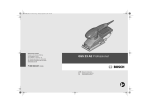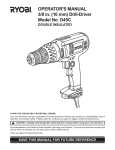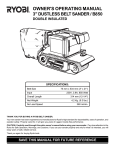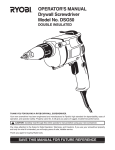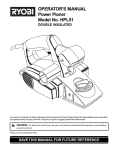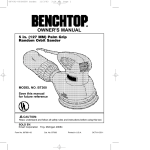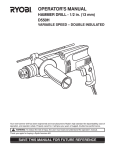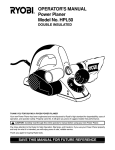Download Ryobi BE318-2 Operator`s manual
Transcript
OPERATOR'S MANUAL BELT SANDER BE318 DOUBLE INSULATED Your new sander has been engineered and manufactured to Ryobi's high standard for dependability, ease of operation, and operator safety. Properly cared for, it will give you years of rugged, trouble-free performance. WARNING: To reduce the risk of injury, the user must read and understand the operator’s manual. Thank you for buying a Ryobi belt sander. SAVE THIS MANUAL FOR FUTURE REFERENCE TABLE OF CONTENTS Introduction ........................................................................................................................................................ 2 General Safety Rules ..................................................................................................................................... 3-4 Specific Safety Rules ......................................................................................................................................... 4 Symbols ............................................................................................................................................................. 5 Specifications .................................................................................................................................................... 6 Unpacking .......................................................................................................................................................... 6 Applications ....................................................................................................................................................... 6 Features ......................................................................................................................................................... 7-8 Operation ...................................................................................................................................................... 9-14 Maintenance ............................................................................................................................................... 14-15 Parts, Ordering, and Service ........................................................................................................................... 16 INTRODUCTION Your sander has many features for making the use of this tool more pleasant and enjoyable. Safety, performance, and dependability have been given top priority in the design of this sander making it easy to maintain and operate. WEAR YOUR SAFETY GLASSES FORESIGHT IS BETTER THAN NO SIGHT WARNING: Do not attempt to use this tool until you have read thoroughly and understand completely the operator’s manual. Pay close attention to the safety rules, including Dangers, Warnings, and Cautions. If you use your tool properly and only for what it is intended, you will enjoy years of safe, reliable service. The operation of any power tool can result in foreign objects being thrown into your eyes, which can result in severe eye damage. Before beginning tool operation, always wear safety goggles or safety glasses with side shields and a full face shield when needed. We recommend Wide Vision Safety Mask for use over eyeglasses or standard safety glasses with side shields. Always wear eye protection which is marked to comply with ANSI Z87.1. Look for this symbol to point out important safety precautions. It means attention!!! Your safety is involved. 2 GENERAL SAFETY RULES WARNING: Read and understand all instructions. Failure to follow all instructions listed below, may result in electric shock, fire and/or serious personal injury. SAVE THESE INSTRUCTIONS WORK AREA Keep your work area clean and well lit. Cluttered benches and dark areas invite accidents. Do not operate power tools in explosive atmospheres, such as in the presence of flammable liquids, gases, or dust. Power tools may create sparks which may ignite the dust or fumes. Keep bystanders, children, and visitors away while operating a power tool. Distractions can cause you to lose control. Remove adjusting keys or wrenches before turning the tool on. A wrench or a key that is left attached to a rotating part of the tool may result in personal injury. Do not overreach. Keep proper footing and balance at all times. Proper footing and balance enables better control of the tool in unexpected situations. Do not use on a ladder or unstable support. Use safety equipment. Always wear eye protection. Dust mask, nonskid safety shoes, hard hat, or hearing protection must be used for appropriate conditions. ELECTRICAL SAFETY Double insulated tools are equipped with a polarized plug (one blade is wider than the other). This plug will fit in a polarized outlet only one way. If the plug does not fit fully in the outlet, reverse the plug. If it still does not fit, contact a qualified electrician to install a polarized outlet. Do not change the plug in any way. Double insulation eliminates the need for the three-wire grounded power cord and grounded power supply system. Avoid body contact with grounded surfaces, such as pipes, radiators, ranges, and refrigerators. There is an increased risk of electric shock if your body is grounded. Don’t expose power tools to rain or wet conditions. Water entering a power tool will increase the risk of electric shock. TOOL USE AND CARE Do not abuse the cord. Never use the cord to carry the tools or pull the plug from an outlet. Keep cord away from heat, oil, sharp edges, or moving parts. Replace damaged cords immediately. Damaged cords increase the risk of electric shock. Do not use tool if switch does not turn it on or off. Any tool that cannot be controlled with the switch is dangerous and must be repaired. Disconnect the plug from power source before making any adjustments, changing accessories, or storing the tool. Such preventive safety measures reduce the risk of starting the tool accidentally. Store idle tools out of the reach of children and other untrained persons. Tools are dangerous in the hands of untrained users. Maintain tools with care. Keep cutting tools sharp and clean. Properly maintained tools with sharp cutting edges are less likely to bind and are easier to control. Check for misalignment or binding of moving parts, breakage of parts, and any other condition that may affect the tool’s operation. If damaged, have the tool serviced before using. Many accidents are caused by poorly maintained tools. Use only accessories that are recommended by the manufacturer for your model. Accessories that may be suitable for one tool, may become hazardous when used on another tool. When operating a power tool outside, use an outdoor extension cord marked “W-A” or “W”. These cords are rated for outdoor use and reduce the risk of electric shock. Stay alert, watch what you are doing and use common sense when operating a power tool. Do not use tool while tired or under the influence of drugs, alcohol, or medication. A moment of inattention while operating power tools may result in serious personal injury. 3 Use clamps or other practical way to secure and support the workpiece to a stable platform. Holding the work by hand or against your body is unstable and may lead to loss of control. Do not force tool. Use the correct tool for your application. The correct tool will do the job better and safer at the rate for which it is designed. PERSONAL SAFETY Dress properly. Do not wear loose clothing or jewelry. Contain long hair. Keep your hair, clothing, and gloves away from moving parts. Loose clothes, jewelry, or long hair can be caught in moving parts or drawn into air vents. Avoid accidental starting. Be sure switch is off before plugging in. Carrying tools with your finger on the switch or plugging in tools that have the switch on, invites accidents. GENERAL SAFETY RULES SERVICE Tool service must be performed only by qualified repair personnel. Service or maintenance performed by unqualified personnel could result in a risk of injury. When servicing a tool, use only identical replacement parts. Follow instructions in the Maintenance section of this manual. Use of unauthorized parts or failure to follow Maintenance Instructions may create a risk of electric shock or injury. SPECIFIC SAFETY RULES Hold tool by insulated gripping surfaces when performing an operation where the tool may contact hidden wiring or its cord. Contact with a “live” wire will make exposed metal parts of the tool “live” and shock the operator. ADDITIONAL SAFETY RULES Make sure your extension cord is in good condition. When using an extension cord, be sure to use one heavy enough to carry the current your product will draw. A wire gage size (A.W.G.) of at least 16 is recommended for an extension cord 100 feet or less in length. A cord exceeding 100 feet is not recommended. If in doubt, use the next heavier gage. The smaller the gage number, the heavier the cord. An undersized cord will cause a drop in line voltage resulting in loss of power and overheating. Know your power tool. Read operator’s manual carefully. Learn its applications and limitations, as well as the specific potential hazards related to this tool. Following this rule will reduce the risk of electric shock, fire, or serious injury. Always wear safety glasses. Everyday eyeglasses have only impact-resistant lenses; they are NOT safety glasses. Following this rule will reduce the risk of serious personal injury. Protect your lungs. Wear a face or dust mask if the operation is dusty. Following this rule will reduce the risk of serious personal injury. Inspect for and remove all nails from lumber before using this tool. Following this rule will reduce the risk of serious personal injury. Protect your hearing. Wear hearing protection during extended periods of operation. Following this rule will reduce the risk of serious personal injury. Drugs, alcohol, medication. Do not operate tool while under the influence of drugs, alcohol, or any medication. Following this rule will reduce the risk of electric shock, fire, or serious personal injury. Inspect tool cords periodically and, if damaged, have repaired at your nearest authorized service center. Constantly stay aware of cord location. Following this rule will reduce the risk of electric shock or fire. Save these instructions. Refer to them frequently and use them to instruct others who may use this tool. If you loan someone this tool, loan them these instructions also. Check damaged parts. Before further use of the tool, a guard or other part that is damaged should be carefully checked to determine that it will operate properly and perform its intended function. Check for alignment of moving parts, binding of moving parts, breakage of parts, mounting, and any other conditions that may affect its operation. A guard or other part that is damaged should be properly repaired or replaced by an authorized service center. Following this rule will reduce the risk of shock, fire, or serious injury. WARNING: Some dust created by power sanding, sawing, grinding, drilling, and other construction activities contains chemicals known to cause cancer, birth defects or other reproductive harm. Some examples of these chemicals are: • lead from lead-based paints, • crystalline silica from bricks and cement and other masonry products, and • arsenic and chromium from chemicallytreated lumber. Your risk from these exposures varies, depending on how often you do this type of work. To reduce your exposure to these chemicals: work in a well ventilated area, and work with approved safety equipment, such as those dust masks that are specially designed to filter out microscopic particles. Do not abuse cord. Never carry the tool by the cord or yank it to disconnect it from the receptacle. Keep cord away from heat, oil, and sharp edges. Following this rule will reduce the risk of electric shock or fire. 4 SYMBOLS Important: Some of the following symbols may be used on your tool. Please study them and learn their meaning. Proper interpretation of these symbols will allow you to operate the tool better and safer. SYMBOL NAME DESIGNATION/EXPLANATION V Volts Voltage A Amperes Current Hz Hertz Frequency (cycles per second) W Watt Power Minutes Time Alternating Current Type or a characteristic of current No Load Speed Rotational speed, at no load Class II Construction Designates double-insulated construction tools Revolutions or Reciprocation Per Minute Revolutions, strokes, surface speed, orbits etc. per minute Safety Alert Indicates danger, warning or caution. It means attention!!! Your safety is involved. Wet Conditions Alert Do not expose to rain or use in damp locations. min n0 .../min The purpose of safety symbols is to attract your attention to possible dangers. The safety symbols, and the explanations with them, deserve your careful attention and understanding. The safety warnings do not by themselves eliminate any danger. The instructions or warnings they give are not substitutes for proper accident prevention measures. SYMBOL MEANING DANGER: Failure to obey a safety warning will result in serious injury to yourself or to others. Always follow the safety precautions to reduce the risk of fire, electric shock and personal injury. WARNING: Failure to obey a safety warning can result in serious injury to yourself or to others. Always follow the safety precautions to reduce the risk of fire, electric shock and personal injury. CAUTION: Failure to obey a safety warning may result in property damage or personal injury to yourself or to others. Always follow the safety precautions to reduce the risk of fire, electric shock and personal injury. NOTE: Advises you of information or instructions vital to the operation or maintenance of the equipment. SAVE THESE INSTRUCTIONS 5 SPECIFICATIONS Belt Size 3 in. X 18 in. (7.6 cm X 45.7 cm) Sanding Surface 15 square in. (96.8 square cm) 700 surface ft./min.* No Load Speed Input 120 Volts, 60 Hz, AC only, 5 amps Net Weight 6.3 lbs. (2.8 kg) * Speed at which the belt moves UNPACKING INSTRUCTIONS PACKING LIST Your sander has been shipped completely assembled. Carefully remove the tool and accessories from the box. Make sure that all items listed in the packing list are included. Inspect the tool carefully to make sure no breakage or damage occurred during shipping. Do not discard the packing material until you have carefully inspected and satisfactorily operated the tool. If any parts are damaged or missing, please call 1-800-525-2579 for assistance. Belt Sander Sanding Belt Dust Collection Bag Operator’s Manual WARNING: If any parts are missing do not operate your tool until the missing parts are replaced. Failure to do so could result in possible serious personal injury. APPLICATIONS You may use your sander for the purposes listed below: Sanding wood, metals, plastics, and other materials. Smoothing rough boards, chamfering, rounding edges, etc. Removing rust, paint, varnishes, and stains. 6 FEATURES DOUBLE INSULATION ELECTRIC MOTOR Double insulation is a concept in safety in electric power tools, which eliminates the need for the usual three-wire grounded power cord. All exposed metal parts are isolated from the internal metal motor components with protecting insulation. Double insulated tools do not need to be grounded. Your sander has a precision built electric motor. It should be connected to a power supply that is 120 volts, 60 Hz, AC only (normal household current). Do not operate this tool on direct current (DC). A substantial voltage drop will cause a loss of power and the motor will overheat. If your tool does not operate when plugged into an outlet, double-check the power supply. WARNING: SWITCH The double insulated system is intended to protect the user from shock resulting from a break in the tool's internal wiring. Observe all normal safety precautions to avoid electrical shock. Your sander has a conveniently located trigger switch. LOCK-ON The lock-on feature allows you to lock the sander on when you operate it continuously for extended periods of time. Important: Servicing of a tool with double insulation requires extreme care and knowledge of the system and should be performed only by a qualified service technician. For service, we suggest you return the tool to your nearest authorized service center for repair. Always use original factory replacement parts when servicing. DUST COLLECTION BAG The dust collection bag attaches to the sander and keeps dust to a minimum. ERGONOMIC DESIGN The design of the sander provides for easy handling. It is designed for comfort and ease of grasp when operating in different positions and at different angles. 7 FEATURES DUST COLLECTION BAG FRONT HANDLE REAR HANDLE TENSION RELEASE LEVER SANDING BELT Fig. 1 WARNING: Do not attempt to modify this tool or create accessories not recommended for use with this tool. Any such alteration or modification is misuse and could result in a hazardous condition leading to possible serious personal injury. 8 OPERATION WARNING: Always wear safety goggles or safety glasses with side shields when operating this tool. Failure to do so could result in dust, shavings, or loose particles being thrown into your eyes, resulting in possible serious injury. TURNING THE SANDER ON/OFF See Figure 2. Follow these directions to turn the sander on and off. To turn on the sander: Depress the switch trigger. To turn off the sander: Release the switch trigger. DEPRESS TO TURN ON SANDER Fig. 2 LOCKING ON See Figure 3. The lock-on feature allows you to lock the sander on when you operate it continuously for extended periods of time. If you have the “lock-on” feature engaged during use and the sander is accidentally disconnected from the power supply, disengage the “lock-on” feature immediately. Also, do not lock the trigger switch if you might need to suddenly stop the sander. LOCK-ON BUTTON WARNING: Before connecting the sander to a power supply, make sure it is not in the “locked-on” position. Failure to do so could result in accidental starting of the tool resulting in possible serious injury. Fig. 3 Follow these directions to lock on. Depress the switch trigger. Push in the lock-on button. Release the switch trigger. Release the lock-on button. NOTE: To release the lock, depress the switch trigger. SELECTING SANDING BELTS Selecting the correct size and type of sanding belt is an important step in achieving a high quality sanded finish. Aluminum oxide, silicon carbide, and other synthetic abrasives are best for power sanding. In general, when sanding, coarse grit removes the most material and fine grit produces the best finish. The condition of the surface to be sanded determines which grit will do the best job. If the surface is rough, start with a coarse grit and sand until the surface is uniform. Then use medium grit to remove scratches left by the coarser grit. Finally, use finer grit for finishing the surface. Always continue sanding with each grit until the surface is uniform. 9 OPERATION USING SANDING BELTS TENSION RELEASE LEVER TO INSTALL/CHANGE SANDING BELTS See Figures 4, 5, and 6. Follow these directions to install/change sanding belts. Unplug the sander. WARNING: Failure to unplug the tool could result in accidental starting causing possible serious injury. Position the sander on its side with the cord on the left. WARNING: Keep hands and fingers clear of front idler roller and spring mechanism at all times. Failure to do so could result in them getting pinched, causing possible serious injury. Raise the tension release lever. NOTE: If you are changing sanding belts, remove the old sanding belt at this time. Install the sanding belt. CAUTION: If the sanding belt is not a bidirectional belt, ensure that the arrow inside the belt is pointing in the direction of the rotation (clockwise when looking into the open side of the sander). Installing unidirectional sanding belts backwards can create a hazardous condition. Align the sanding belt to its correct position. Lower the tension release lever to secure the sanding belt. Fig. 4 SANDING BELT Fig. 5 INSTALL UNIDIRECTIONAL BELTS IN THE DIRECTION OF THE ROTATION INSTALL BIDIRECTIONAL BELTS IN EITHER DIRECTION 10 Fig. 6 OPERATION TO ADJUST SANDING BELT TRACKING See Figures 7 and 8. Belt life is greatly increased if you regularly adjust the sanding belt tracking. When correctly adjusted, the outer edge of the sanding belt should be even with the outer edge of the base of the sander. When you install a new sanding belt, you may need to adjust the sanding belt tracking several times until the belt becomes pliable. Follow these directions to adjust sanding belt tracking. WARNING: Before connecting the sander to a power supply, always make sure it is not in the “locked-on” position. Failure to do so could result in accidental starting of the sander resulting in possible serious injury. Fig. 7 Connect the sander to a power supply. Position the sander upside down with the cord on the left. NOTE: This position is for adjustments only. The sanding belt should not contact a workpiece or any foreign object when you are making belt tracking adjustments. Depress the switch trigger and release immediately. If sanding belt runs inward: Turn the tracking screw slowly counterclockwise. If sanding belt runs outward: Turn the tracking screw slowly clockwise. TURN COUNTERCLOCKWISE IF BELT RUNS INWARD TURN CLOCKWISE IF BELT RUNS OUTWARD NOTE: Turn the tracking screw until you are sure the sanding belt is secure, i.e, it will not come off the sander or contact internal parts. CAUTION: If the sanding belt wears excessively on the inner edge, it is probably adjusted too far inward and is rubbing against internal parts. If this is the case, readjust the tracking screw. Start the sander and fine adjust the tracking screw until the belt stablizes. WARNING: Keep hands and fingers away from a moving sanding belt. Any part of the body coming in contact with a moving sanding belt could result in serious injury. Do not wear loose clothing or jewelry when operating the sander. They could get caught in moving parts and foreign objects could get thrown away from the sander causing injury. 11 Fig. 8 OPERATION USING THE DUST COLLECTION BAG The dust collection bag provides a dust collection system for the sander. BLOWER EXHAUST HOLE TO ATTACH THE DUST COLLECTION BAG See Figure 9. Follow these directions to attach the dust collection bag. Unplug the sander. WARNING: Failure to unplug the tool could result in accidental starting causing possible serious injury. Slide the dust bag retainer over the blower exhaust hole on the sander. DUST BAG RETAINER TO EMPTY THE DUST COLLECTION BAG For more efficient operation, empty the dust collection bag when it is no more than half full. This action permits the air to flow through the bag better. Always empty and clean the dust collection bag thoroughly upon completion of a sanding operation and before placing the sander in storage. Fig. 9 WARNING: Collected sanding dust from sanding surface coatings such as polyurethanes, linseed oil, etc. can selfignite in your sander dust collection bag or elsewhere and cause fire. To reduce the risk of fire always empty your dust bag frequently (10-15 minutes) while sanding and never store or leave a sander without totally emptying its dust bag. Also follow the recommendations of the coatings manufacturers. Follow these directions to empty the dust collection bag. Unplug the sander. WARNING: Failure to unplug the tool could result in accidental starting causing possible serious injury. Remove the dust collection bag from the sander. Unzip the dust bag. Shake out the dust. Zip up the dust bag. Replace the dust collection bag. NOTE: Periodically, you should turn the dust bag inside-out and thoroughly clean it. 12 OPERATION OPERATING THE SANDER See Figure 10. Follow these steps to operate the sander. Secure the work to prevent it from moving under the sander. WARNING: Unsecured work could be thrown towards the operator causing injury. Turn the sander on and let the motor reach its maximum speed before placing the sander on the work surface. Lower the sander to the work surface with a slight forward motion. Move the sander slowly over the work surface, using the rear handle to control the sander and the front handle to guide the sander. Fig. 10 NOTE: Allowing the sander to remain in one place will result in an uneven surface. WARNING: Keep a firm grip on the sander with both hands at all times. Failure to do so could result in loss of control leading to possible serious injury. We designed the sander to provide the proper weight on the sanding belt. Excessive pressure will result in the following: Uneven work. Clogged sanding belts. Premature sanding belt wear. Possible motor burnout. Irregular sanding belt tracking. Fig. 11 PROPER HAND PLACEMENT See Figure 11. For ease of operation and maintaining proper control, the sander has a front handle and a rear handle. These handles allow two-handed operation, which aids in maintaining control, keeping the sanding area level with the workpiece, and keeping hands clear of the sanding belt. When operating the sander, always hold the front handle with your left hand and the rear handle with your right hand. WARNING: Do not let your fingers rest over the front or right edge of the sander. If the sanding belt were to run off, or if it were not properly adjusted, your fingers could come in contact with the moving sanding belt resulting in possible serious injury. WARNING: Keep hands and fingers clear of moving sanding belt, front idler roller, and driver roller assembly. Failure to do so will result in serious personal injury. 13 OPERATION The front roller of the sander is not designed for contour sanding. Sanding on the front roller could cause irregularity in the sanding belt tracking. HELPFUL TIPS If the sanding belt slips or doesn’t track while sanding, you may be applying too much pressure. When this occurs, remove the sander from the workpiece. If you properly adjust the belt tracking, the sanding belt will return to its normal and correct position on the driver roller and front roller. Use a coarser sanding belt for heavy sanding, not heavy pressure. The weight of the tool is sufficient to provide adequate pressure at the correct location. MAINTENANCE WARNING: When servicing use only identical Ryobi replacement parts. Use of any other parts may create a hazard or cause product damage. Electric tools used on fiberglass material, wallboard, spackling compounds, or plaster are subject to accelerated wear and possible premature failure, as the fiberglass chips and grindings are highly abrasive to bearings, brushes, commutators, etc. Consequently, we do not recommend that this tool be used for extended work on these types of materials. If, however, you do work with any of these materials, it is extremely important that you clean the tool frequently by blowing it with an air jet. GENERAL Avoid using solvents when cleaning plastic parts. Most plastics are susceptible to damage from various types of commercial solvents and may be damaged by their use. Use clean cloths to remove dirt, carbon dust, etc. WARNING: Do not at any time let brake fluids, gasoline, petroleum-based products, penetrating oils, etc. come in contact with plastic parts. They contain chemicals that can damage, weaken, or destroy plastic. WARNING: Always wear safety goggles or safety glasses with side shields during power tool operation or when blowing dust. If operation is dusty, also wear a dust mask. 14 MAINTENANCE REPLACING THE TIMING BELT See Figures 12 and 13. Follow these directions to replace the timing belt. Unplug the sander. WARNING: Failure to unplug the tool could result in accidental starting causing possible serious injury. Remove the sanding belt from the sander. Refer to “TO INSTALL/CHANGE SANDING BELTS” earlier in this manual. Remove the belt cover screws and the belt cover. SMALL PULLEY TIMING BELT WARNING: LARGE PULLEY Fig. 12 Never attempt to operate the belt sander without the belt cover in place. Force the old timing belt from the small pulley with a screwdriver and remove it from the large pulley. NOTE: If the timing belt is worn, simply cut it and remove it. Install the new timing belt over the small pulley. Hold the timing belt as shown. Press the belt onto the large pulley turning it as you press the belt on. Replace the belt cover and screws. Tighten the screws securely. Fig. 13 15 OPERATOR'S MANUAL BELT SANDER BE318 DOUBLE INSULATED EXTENSION CORD CAUTION When using a power tool at a considerable distance from a power source, be sure to use an extension cord that has the capacity to handle the current the tool will draw. An undersized cord will cause a drop in line voltage, resulting in overheating and loss of power. Use the chart to determine the minimum wire size required in an extension cord. Only round jacketed cords should be used. When working with a tool outdoors, use an extension cord that is designed for outside use. This is indicated by the letters "WA" on the cord's jacket. Before using any extension cord, inspect it for loose or exposed wires and cut or worn insulation. **Ampere rating (on tool faceplate) 0-2.0 Cord Length 2.1-3.4 3.5-5.0 5.1-7.0 7.1-12.0 12.1-16.0 Wire Size (A.W.G.) 25' 16 16 16 16 14 14 50' 16 16 16 14 14 12 100' 16 16 14 12 10 — CAUTION: Keep the extension cord clear of the working area. Position the cord so that it will not get caught on lumber, tools or other obstructions while you are working with a power tool. **Used on 12 gauge - 20 amp circuit. • SERVICE Now that you have purchased your tool, should a need ever exist for repair parts or service, simply contact your nearest Ryobi Authorized Service Center. Be sure to provide all pertinent facts when you call or visit. Please call 1-800-525-2579 for your nearest Ryobi Authorized Service Center. You can also check our Web site at www.ryobitools.com for a complete list of Authorized Service Centers. • MODEL NO. AND SERIAL NO. The model number of this tool will be found on a plate attached to the motor housing. Please record the model number and serial number in the space provided below. • HOW TO ORDER REPAIR PARTS WHEN ORDERING REPAIR PARTS, ALWAYS GIVE THE FOLLOWING INFORMATION: • MODEL NUMBER • SERIAL NUMBER BE318 RYOBI TECHNOLOGIES INC. 1428 Pearman Dairy Road Anderson, SC 29625 Post Office Box 1207 Anderson, SC 29622 www.ryobitools.com Phone 1-800-525-2579 983000-130 7-03
















